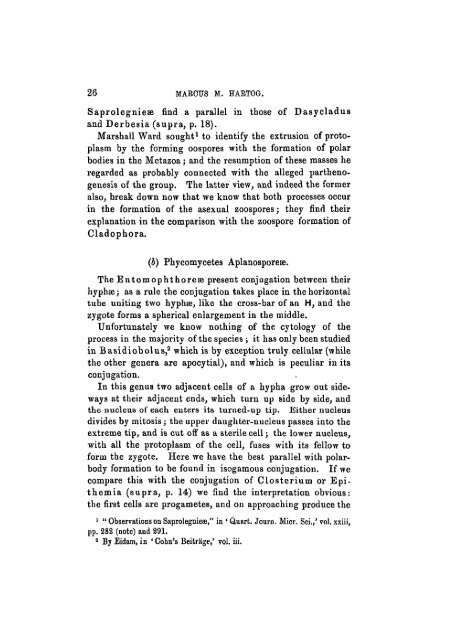Some Problems of Reproduction: a Comparative Study of ...
Some Problems of Reproduction: a Comparative Study of ...
Some Problems of Reproduction: a Comparative Study of ...
You also want an ePaper? Increase the reach of your titles
YUMPU automatically turns print PDFs into web optimized ePapers that Google loves.
26 MARCUS M. HAETOG.<br />
Saprolegniese find a parallel in those <strong>of</strong> Dasycladus<br />
and Derbesia (supra, p. 18).<br />
Marshall Ward sought 1 to identify the extrusion <strong>of</strong> protoplasm<br />
by the forming oospores with the formation <strong>of</strong> polar<br />
bodies in the Metazoa; and the resumption <strong>of</strong> these masses he<br />
regarded as probably connected with the alleged parthenogenesis<br />
<strong>of</strong> the group. The latter view, and indeed the former<br />
also, break down now that we know that both processes occur<br />
in the formation <strong>of</strong> the asexual zoospores; they find their<br />
explanation in the comparison with the zoospore formation <strong>of</strong><br />
Cladophora.<br />
(b) Phycomycetes Aplanosporese.<br />
The Entomophthorese present conjugation between their<br />
hyphse; as a rule the conjugation takes place in the horizontal<br />
tube uniting two hyphse, like the cross-bar <strong>of</strong> an H, and the<br />
zygote forms a spherical enlargement in the middle.<br />
Unfortunately we know nothing <strong>of</strong> the cytology <strong>of</strong> the<br />
process in the majority <strong>of</strong> the species ; it has only been studied<br />
in Basidiobolus, 2 which is by exception truly cellular (while<br />
the other genera are apocytial), and which is peculiar in its<br />
conjugation.<br />
In this genus two adjacent cells <strong>of</strong> a hypha grow out sideways<br />
at their adjacent ends, which turn up side by side, and<br />
the nucleus <strong>of</strong> each enters its turned-up tip. Either nucleus<br />
divides by mitosis; the upper daughter-nucleus passes into the<br />
extreme tip, and is cut <strong>of</strong>f as a sterile cell; the lower nucleus,<br />
with all the protoplasm <strong>of</strong> the cell, fuses with its fellow to<br />
form the zygote. Here we have the best parallel with polarbody<br />
formation to be found in isogamous conjugation. If we<br />
compare this with the conjugation <strong>of</strong> Closterium or Epithemia<br />
(supra, p. 14) we find the interpretation obvious:<br />
the first cells are progametes, and on approaching produce the<br />
1<br />
" Observations on Saprolegniese," in ' Quart. Journ. Micr. Sci.,' vol. xxiii,<br />
pp. 282 (note) and 291.<br />
3<br />
By Eidam, in ' Conn's Beitrage,' vol. iii.

















